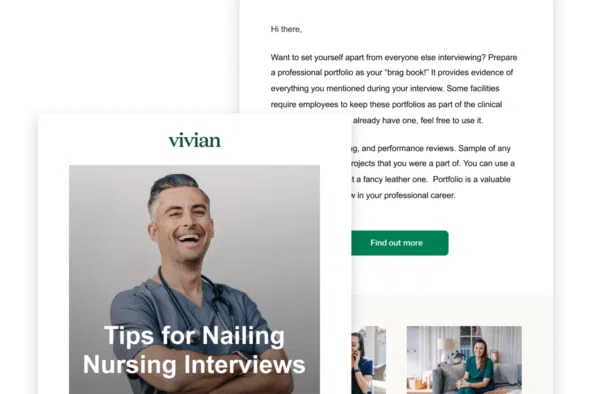Nursing is a rewarding career, but it’s tough balancing full-time work with everything else you have going on, especially if you have young children or care for an elderly parent. Fortunately, you don’t have to choose between your job and your personal life. Per diem nursing is one of the most flexible employment options available to registered nurses (RNs) and licensed practical nurses (LPNs). Keep reading to learn more about per diem nursing and how it benefits employers, plus get tips for landing high-paying per diem nursing jobs.
What Is Per Diem Nursing?
Per diem nursing, also called PRN nursing, involves working on an as-needed basis instead of committing to a full-time or part-time schedule. Per diem is Latin for “by the day,” although per diem nurses also work evening and night shifts.
Not all facilities structure their PRN programs the same way, so read each job posting carefully to find out what it entails. For example, one job may have you working at the same hospital each shift, while another has you rotating through several facilities owned by a large healthcare system.
Some PRN positions are temporary, while others involve long-term employment opportunities. Many facilities bring on per diem nurses before the holidays, expecting more staff members than usual to request time off. You may also find more per diem opportunities than usual during the summer when many employees take vacations.
If you land a long-term PRN job, the facility may call you when another nurse calls in sick to see if you’re available to cover one or more shifts until their return. Hospitals may also call in per diem nurses if a natural disaster or other mass casualty incidents create an immediate need for more nurses. If staff nurses at a unionized hospital strike, the facility may call in PRN nurses, but they often rely on travel nurses because of the large number of nurses they need to cover shifts throughout a strike.
Employment Options
Staff nurses find per diem nursing jobs in various healthcare settings. These jobs may be available in the following types of facilities:
- General Medical and Surgical Hospitals
- Specialty Hospitals
- Urgent Care Centers
- Freestanding Emergency Departments
- Outpatient Clinics
- Skilled Nursing Facilities
Per diem travel nursing is also an option, combining the flexibility of PRN work with the benefits of traveling around the country. However, it’s not always realistic based on travel costs, housing issues and licensure.
As of February 2023, 39 states or U.S. territories enacted the Enhanced Nurse Licensure Compact (eNLC), though one state and two territories hadn’t fully implemented the eNLC. Nurses who qualify for a multistate Compact license in one participating state can practice in another participating state without obtaining additional licensure.
If you want to work as a travel per diem nurse in a state that hasn’t adopted the eNLC, you must go through that state’s licensure process before accepting assignments.
Travel per diem nursing allows you to move whenever you want instead of being stuck in a contract, but the drawback is you’re on the hook for your travel and housing expenses. You must have the ability to pay your own way to make this arrangement worthwhile.
Although it’s possible to do per diem travel nursing, you should also be aware that many hospitals won’t hire travel nurses on an as-needed basis. Travel assignments usually last for several weeks and tend to require full-time schedules.
Some travel and staff nurses may work full-time for one facility and work per diem shifts for another facility as a side hustle. Depending on a per diem nurse’s agreement with a facility, they may take a 13-week travel contract in another state, then return home to their per diem role. These arrangements help travel nurses keep their permanent tax home, which is needed to qualify for tax-free stipends.
Benefits for Employers
Hiring PRN nurses has several benefits for employers. One of the most significant is the ability to maintain safe staffing ratios. When a department is short-staffed, nurses and other employees have to juggle even more responsibilities, leaving them with less time to check on patients and keep an eye out for complications. Per diem nurses help fill in the gaps, promoting a safer environment.
Implementing a PRN nursing program also helps healthcare facilities save money. When a hospital hires a full-time nurse, they typically provide health insurance, tuition reimbursement and other valuable benefits, increasing the total cost of employing each person. In most cases, PRN nurses aren’t eligible for these benefits, making it possible to address staffing shortages without hiring as many full-time employees.
Additionally, hiring per diem nurses helps healthcare facilities keep their recruiting costs in check. For example, if a hospital needs an RN to cover someone’s maternity leave, they don’t have to go through the trouble of placing advertisements, conducting interviews and performing background checks on candidates. They can simply ask some of their per diem nurses to cover until the full-time nurse returns.
Earning Potential for Per Diem Nurses
According to Vivian Health’s salary data for the week ending February 11, 2023, per diem nurse jobs paid an average of $51 per hour. However, the amount you earn depends on where you live, what type of nursing you prefer and which employer you choose.
For example, facilities in Texas were offering between $57 and $60 per hour for per diem nurses in intensive care, interventional radiology and the emergency department. Conversely, Florida tends to have lower-than-average rates for per diem nurses, especially in locations such as The Villages, West Palm Beach, Bradenton and Jupiter. Jobs in these areas paid about $31 to $47 per hour during the same period.
Your choice of specialty significantly impacts your earnings as a PRN nurse. For example, one staffing agency in Galveston, Texas, offered $70 per hour for nurses willing to work in the ICU or PACU. The same agency only paid $58 per hour for nurses working in pediatrics and labor and delivery during the same period. Generally, the more specialized your skills, the more you’ll earn as a per diem nursing professional.
No matter where you work, per diem nursing usually pays better than working as a full-time staff nurse. Most facilities pay a percentage more than your base rate (full-time equivalent) or may have a set hourly wage for per diem nurses. Some healthcare systems regularly use per diem nurses to help staff their facilities and pay them extremely well to participate in those programs.
Advantages of Per Diem Nursing
The biggest advantage of per diem nursing is flexibility, which enhances your work/life balance. Some hospitals allow per diem nurses to work just a few hours per day, making this job something you can do after you get the kids off to school in the morning. If you care for an elderly parent, working as a PRN nurse gives you more days off to take them to medical appointments or simply enjoy spending time with them. Per diem work is also ideal if you’re enrolled in a BSN or MSN program and need extra time to study or complete clinical education requirements.
PRN nursing is also a great way to ease the transition from full-time work to retirement. As you get older, you may find it tough to spend every day on your feet, but that doesn’t mean you have to give up your entire career. Per diem nursing jobs allow you to work a few days per week, keeping your mind occupied and your skills current until you’re ready to move on.
When you work in the same department all the time, you get used to doing the same tasks day after day. After a while, you may find the job less rewarding. Depending on how your facility’s PRN program works, you could rotate through several departments, allowing you to learn new skills and continue challenging yourself as a nurse. As a bonus, working in multiple departments makes building relationships with other healthcare professionals easier.
Disadvantages of Per Diem Nursing
Despite its advantages, per diem nursing has some drawbacks. For example, most facilities don’t offer benefits to PRN nurses. If you’re married, look into signing up for your spouse’s health plan. You may also be able to buy coverage on the federal Health Insurance Marketplace or your state’s health insurance exchange.
You probably won’t qualify for paid time off, either. That means you won’t get paid for any days you have to miss due to medical appointments, vacations, family obligations and other activities. On the plus side, you don’t have to get vacation time approved. You simply don’t schedule yourself during whatever time you want off. PRN nurses also don’t have as many required holiday commitments as staff nurses.
Another disadvantage is that you may not get as many shifts as you need to cover your expenses. In some cases, you won’t get called in to work unless another nurse calls off or there’s a sudden need for additional nursing staff. If you only work a couple of days per week, you won’t make as much as you would if you worked a steadier part-time job.
If you get floated to a department where you don’t have much experience, you may need time to adjust, making the job more stressful. Most staff nurses are happy to have extra help but don’t take it personally if someone seems frustrated by your questions or your lack of familiarity with the department’s policies and procedures. Their frustration likely lies with their working conditions, not with you personally.
What to Expect From Per Diem Nursing Jobs
Every per diem nursing job is a little different, so ask your nurse manager what to expect on your first day of work. Generally, you let the facility know when you’re available, such as day shifts on Mondays and Wednesdays or night shifts on Saturdays and Sundays.
If a facility requires coverage during the shifts you’ve indicated you’re available to work, expect a phone call telling you when and where to report. Sometimes these calls come in just a few hours before you’re needed, so it’s a good idea to have a clean uniform pressed and ready to go at a moment’s notice.
Some facilities require per diem staff to commit to a certain number of shifts per pay period, while others do monthly commitments. Make sure you understand the requirements before you accept a PRN role. It’s better to turn down a job than to accept it and have difficulty following through on your commitment.
How to Succeed as a Per Diem Nurse
Working as a per diem nurse allows you to make a good impression on employers and other nursing professionals. Here are a few things you can do to establish yourself as a team player with just the right combination of knowledge and skills:
- Keep a notepad and pen in your pocket: Taking notes makes it easier to remember department-specific procedures each time you get floated to a new unit.
- Introduce yourself to as many staff members as possible: Let them know you’d appreciate their guidance as you adjust to your new role.
- Don’t be afraid to ask questions: It’s better to ask for help than to make a critical mistake because you were afraid to speak up.
- Accept as many shifts as possible: If you’re flexible, nurse managers may offer you more opportunities to work.
Above all, keep your cool in tense situations. If you disagree with another staff member, choose your words wisely and always behave professionally. Even if you only work a few days per month, you’ll likely work with the same person again, so look for ways to collaborate effectively and deliver the best possible patient care.
Start your search today by browsing our entire selection of per diem/PRN RN jobs to find the specialty, location and facility that meets your needs.







